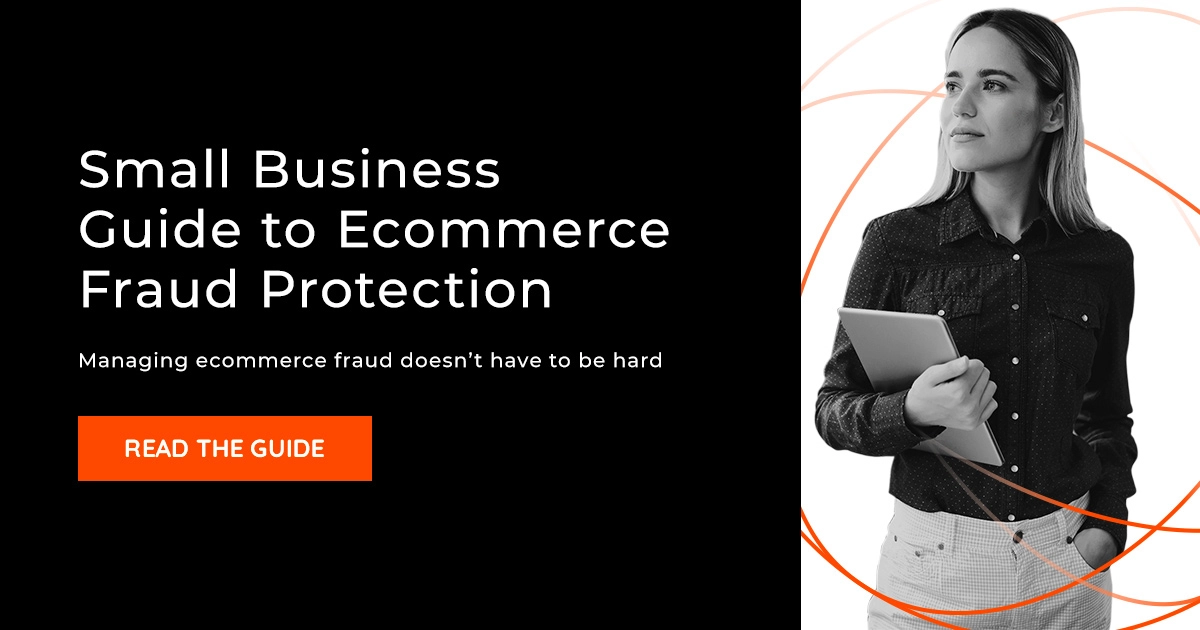Why SMBs Make Perfect Ecommerce Fraud Targets
You have a thriving online store, but your business is relatively small. You don’t need to worry about fraud, right?
While it’s possible you’re lucky enough to somehow fly under the fraudster radar, no ecommerce business is completely “risk-free.” Just as online shopping increased rapidly during the pandemic, ecommerce fraud skyrocketed as well, putting every business at risk. Here’s why small and mid-size businesses need to be vigilant about fraud prevention.
Regardless of the industry, location or size of your business, preventing online fraud should always be a priority. Why? Because today’s ecommerce consumers expect their favorite stores to protect them.
Ecommerce Fraud Is a Real Concern
In our original research on the state of consumer attitudes on ecommerce fraud, we discovered that consumers are reluctant to make purchases when they don’t trust an online store.
Specifically, customers are deterred when:
- They don’t know if the store is legitimate (58%)
- They’re concerned about becoming the victim of a scam (56%)
- They aren’t sure if the store has adequate security measures in place (41%)
Those concerns are valid. More than half of ecommerce consumers encountered some type of fraudulent activity online in 2021.
Small businesses are feeling the pain as well.
How Ecommerce Businesses Become Susceptible to Fraud
Juniper Research recently reported that online payment fraud will cost small businesses more than $206 billion cumulatively between 2021 and 2025. That means, rather than being too small to be noticed by ecommerce fraudsters, small and mid-size businesses (SMBs) are finding themselves to be prime targets.
In fact, as ecommerce SMBs experience growth, they can unknowingly set themselves up for fraud. Here are a few ways that can happen:
Introducing expensive or high value new products
New products are exciting. When marketed correctly, they generate a lot of hype and, hopefully, increased sales. At the same time, expensive and high-demand products are easy targets for fraud. If the product is small enough to fit in a shoe box, for example, as is the case with many luxury and consumer goods, there’s an even higher risk of fraud.
Another growth tactic that attracts fraudsters is cross-border expansion.
Expanding into new regions and markets
The world is becoming smaller as more consumers shop online. Never before has it been so easy to buy goods anywhere in the world. It’s no wonder that SMBs want to take advantage of that opportunity. But the risks increase considerably when businesses expand into new regions without a plan to prevent fraud. We’ve seen too many SMBs decide to go international without much fraud foresight and find themselves swimming in thousands of chargebacks.
Assuming their payment processors handle chargebacks
Small business owners are busy. It’s not uncommon for them to assume that their payment processor will assume the risks associated with payments. Granted, platforms like Shopify have tools and programs to help identify fraud and “protect” orders, but that isn’t necessarily a guarantee. Too many chargebacks can sink a small business quickly.
How do SMBs know if they’ve attracted the attention of a fraudster?
Ecommerce Fraud Schemes That Impact SMBs
Fraudsters are clever. In the same way that your company targets and markets to individual consumer groups, fraudsters know which schemes work best in specific situations and markets.
Account takeover (ATO) fraud
Account takeover (ATO) fraud is essentially identity theft and happens when a fraudster uses part of a victim’s identity, such as their Social Security number or email address, to take over their account. It has been an increasing threat for years. ATO fraud has been a growing concern for years and accounted for every fifth login attempt and 13% of U.S. ecommerce fraud costs in 2021.
SMBs with recurring charges – such as subscription-based products – are particularly at risk for ATO fraud. Between company staff and customers, it’s easy to overlook any changes to transaction data.
How do fraudsters get the customer data?
- Data breaches and database leaks, make it easy for fraudsters to get their hands on user data.
- Phishing scams through email, text messages, or even social media install malware designed to give fraudsters access to customer devices.
- Despite the popularity of contactless payments, fraud related to card skimmers is increasing at a rate of nearly 10% per year.
Triangulation fraud
Triangulation fraud is the type of trickery that today’s consumers worry about. It happens when an innocent customer makes a purchase on a third-party site set up to mimic a legitimate website.
Here’s how it works:
- A fraudster sets up a third-party marketplace to look like a legitimate online store.
- A valid customer purchases a product on the third-party marketplace.
- The fraudster collects the valid customer’s shipping and payment information and orders the same product from a legitimate retailer.
- The fraudster provides shipping information for the valid customer and payment information stolen from another customer on the legitimate retailer’s site.
- The legitimate retailer processes the fraudster’s order, shipping it to the valid customer’s address provided during checkout and charging the innocent victim’s credit card.
- The valid customer receives the actual item they ordered, but they’re credit card information is now likely to be used in another transaction with another valid customer.
Chargeback fraud
Chargeback fraud happens when a customer makes a legitimate credit card purchase, receives the product or service, and intentionally files a chargeback through the credit card company with the goal of receiving a full refund and keeping the product.
This type fraud can do quite a bit of damage to your bottom line: Every $100 lost in chargebacks, costs an SMB $240 in time, fees, physical goods, and shipping costs. That’s not even considering the fees and penalties your business can incur if your chargeback rate is too high.
As SMBs grow, they may see more policy abuse, such as wardrobing and other types of return fraud.
Not all SMBs are naïve about the need to prevent fraud, but their tactics aren’t necessarily effective.
Common SMB Ecommerce Fraud Tactics
When it comes to fighting fraud, SMB owners tend to lean on three options:
- Assume they won’t be targeted by ecommerce fraud, which risks their revenue, their merchant account, and their reputation.
- Handle fraud prevention in-house, which eats up time and resources better spent on more strategic business activities.
- Set fraud filters to maximum sensitivity, which trades a fraud problem for a false decline problem.
Unfortunately, we often don’t hear from small and mid-size businesses until they have a fraud problem that needs urgent attention. Even if you believe your ecommerce store is one of the lucky businesses that somehow has no fraud, it makes sense to talk to a fraud prevention partner and find out what you may be missing.
How ClearSale Helps Ecommerce SMBs Fight Fraud
At ClearSale, our hybrid solution includes multiple strategies to offer one of the most comprehensive fraud and chargeback prevention solutions on the market.
How our hybrid solution works
It starts with an AI-enabled algorithm that leverages trends, intelligence and data gathered from decades of fighting fraud in the most high-risk regions of the world. Using this technology, we can automatically approve most orders quickly.
Of course, machines aren’t perfect – at least, not yet. Where other solutions lean solely on AI to cut costs, ClearSale leverages experience – but only in the instances where it’s absolutely necessary to guarantee that an order is safe to approve. That’s where ClearSale stands out.
Contextual reviews increase trust
Suspicious orders are flagged for contextual secondary reviews performed by our more than 2,000 fraud analysts who have the experience to recognize some of the hardest-to-spot fraud patterns. If necessary, our analysts may reach out to customers, but they do so in a way that demonstrates why consumers can trust your business to protect their information.
“At ClearSale, we generate, create, and nurture trust. The best we can do to enhance trust is deliver a frictionless process. Our process only applies contextual review to the 2%-3% of orders that need to be looked at. By helping companies identify where they need to apply the right tools, we can decrease friction and increase trust.”

Sarah Elizabeth, ClearSale Senior Director, Growth Strategy
More data means better accuracy
Finally, we leverage the data gathered from those contextual reviews to help our system better distinguish valid transactions from fraud. That means our system can more easily recognize “good” transactions as we process more for the client, which increases their approval rates and revenue.
ClearSale also offers end-to-end chargeback management
For every possibility, ClearSale has a range of chargeback solutions for SMBs:
- Total Chargeback Protection allows businesses to recoup a portion of losses due to fraudulent transactions.
- Chargeback Guarantee reimburses the transaction amount plus the chargeback amount for any unauthorized transaction that’s approved.
- End-to-End Chargeback Management delivers comprehensive chargeback mitigation and resolution services, including team training, data audits and timely responses to issuers.
Find out how your SMB can stop fraudsters in their tracks. Contact ClearSale today for a free consultation.
 Luis Casillas
Luis Casillas



